ikfoundation.org
Promoting Natural & Cultural History
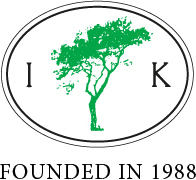


ESSAYS |
COMMEMORATIVE PRINTED TEXTILES
– Queen Victoria and Edward VII
A unique collection of nine commemorative tray cloths, handkerchiefs, towels and scarfs printed on cotton or silk between 1863 and 1909 are included in the Social History Collection at Whitby Museum. These textiles are not locally produced but could still have a local stamp because of a connection with the shop where they were bought/sold. The aim of this historical essay is to give details of such prints and commemorative links to Queen Victoria and Edward VII – together with innovations of the time, World Exhibitions and the British Empire.
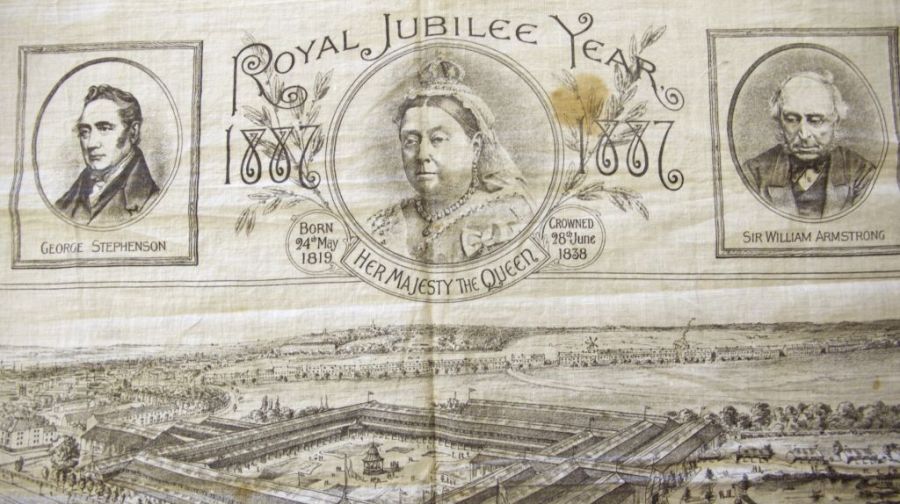 Jubilee year scarf to celebrate Queen Victoria’s “Royal Jubilee Year 1887”. The Mining, Engineering & Industrial Exhibition – Newcastle upon Tyne 1886, is one of the depicted events on this scarf. Print in black on unbleached cotton, 54×54 cm in size. (Owner: Whitby Museum, SOH595). Photo: The IK Foundation, London.
Jubilee year scarf to celebrate Queen Victoria’s “Royal Jubilee Year 1887”. The Mining, Engineering & Industrial Exhibition – Newcastle upon Tyne 1886, is one of the depicted events on this scarf. Print in black on unbleached cotton, 54×54 cm in size. (Owner: Whitby Museum, SOH595). Photo: The IK Foundation, London.Souvenirs of this kind were printed in considerable quantities and reasonably priced despite the fact that the finest might be printed on unbleached silk or on cotton with a ribbed woven edge. Even cheaper was a pattern printed on unbleached smooth cotton or, quite simply, on paper. All these examples in the Whitby collection were printed on fabric using engraved copper plates and ordinary printing inks, in most cases in a single colour.
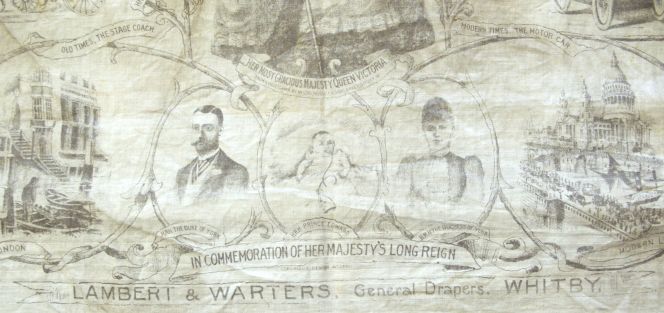 Commemorative handkerchief, print including the name of a local draper’s shop – ‘Lambert & Warters General Drapers Whitby’. (Owner: Whitby Museum, SOH596). Photo: The IK Foundation, London.
Commemorative handkerchief, print including the name of a local draper’s shop – ‘Lambert & Warters General Drapers Whitby’. (Owner: Whitby Museum, SOH596). Photo: The IK Foundation, London.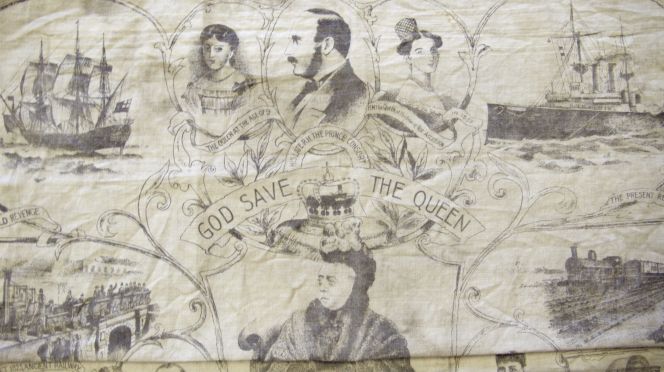 Centre part of the same handkerchief (Owner: Whitby Museum, SOH596). Photo: The IK Foundation, London.
Centre part of the same handkerchief (Owner: Whitby Museum, SOH596). Photo: The IK Foundation, London.One of these – shown in the two illustrations above – is interesting from a local (Whitby) point of view, since ‘Lambert & Waters General Drapers Whitby’ has been printed on a handkerchief commemorating the Diamond Jubilee of Queen Victoria in 1897. It measures 49 by 49 cm and consists of tabby woven cotton with a ribbed woven edge. The Queen is in the centre surrounded by members of her family and features of Victorian transport such as a railway, steamship and early car, etc. These prints must have been sold at the named drapery – Manchester House, Fishburn Park in Whitby – during the jubilee year of 1897.
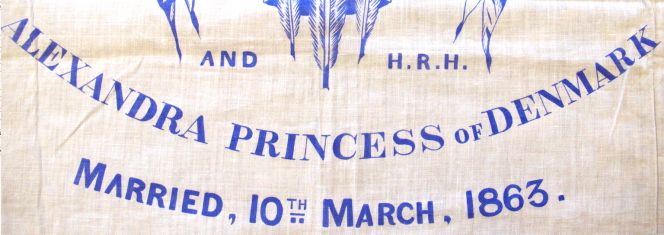 Close-up depiction of a tray cloth to celebrate the marriage of H.R.H. Albert Edward to H.R.H. Alexandra in 1863. Printed in blue on unbleached cotton, 75×63 cm in size. (Owner: Whitby Museum, 2002/39.2). Photo: The IK Foundation, London.
Close-up depiction of a tray cloth to celebrate the marriage of H.R.H. Albert Edward to H.R.H. Alexandra in 1863. Printed in blue on unbleached cotton, 75×63 cm in size. (Owner: Whitby Museum, 2002/39.2). Photo: The IK Foundation, London.Five other prints were produced instead for Queen Victoria’s Golden Jubilee ten years earlier. With Victoria always in the centre the illustrations vary but mostly feature her children and grandchildren, Prime Ministers during her reign, industrial exhibitions and maps of the colonies. The earliest item in the collection is a tray cloth ‘to commemorate the marriage of H.R.H. Albert Edward to H.R.H. Alexandra, 1863’.
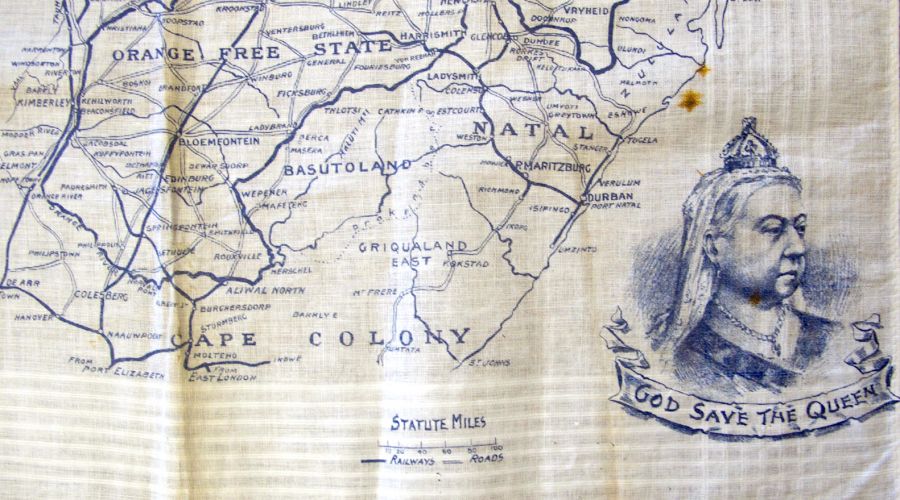 Handkerchief to remember the Jubilee of Queen Victoria (not dated, but probably 1887) with “Cape Colony” map. To emphasise the wide-stretching British Empire which gave increased power and possibilities for trade etc – from a British perspective – was a reoccurring theme for such prints. The collection includes two identical examples with this particular print in blue on unbleached cotton, 43×46 cm in size. (Owner: Whitby Museum, SOH1781). Photo: The IK Foundation, London.
Handkerchief to remember the Jubilee of Queen Victoria (not dated, but probably 1887) with “Cape Colony” map. To emphasise the wide-stretching British Empire which gave increased power and possibilities for trade etc – from a British perspective – was a reoccurring theme for such prints. The collection includes two identical examples with this particular print in blue on unbleached cotton, 43×46 cm in size. (Owner: Whitby Museum, SOH1781). Photo: The IK Foundation, London.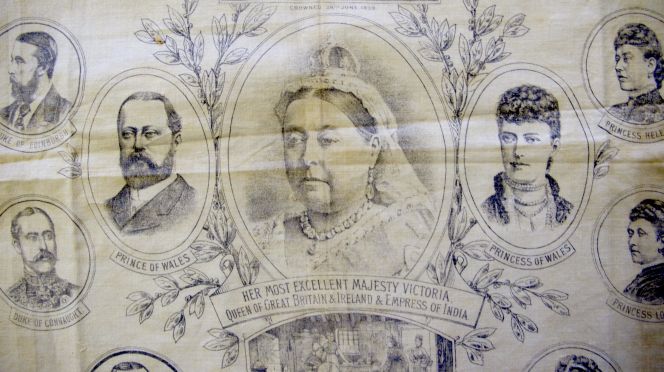 A second handkerchief to commemorate the same Jubilee of Queen Victoria in 1887, including illustrations of her family and Prime Ministers during her reign. Print in black on unbleached cotton, 58×58 cm in size. (Owner: Whitby Museum, SOH1783). Photo: The IK Foundation, London.
A second handkerchief to commemorate the same Jubilee of Queen Victoria in 1887, including illustrations of her family and Prime Ministers during her reign. Print in black on unbleached cotton, 58×58 cm in size. (Owner: Whitby Museum, SOH1783). Photo: The IK Foundation, London.The two latest show the new king Edward VII in 1901 printed in full colour on cotton, and a silk scarf of 1909 in honour of an ‘Alaskan Pacific Exposition’ (not illustrated). It is probable that most of these relatively inexpensive commemorative items were bought in Whitby, either from the Lambert & Waters drapery or from one of the other local textile-orientated shops. Popular modern prints like these could attract a wide public, since they could either be used commemorative in the home, or simply as practical furnishing details or could even, if printed on silk, be worn by their owner as a scarf.
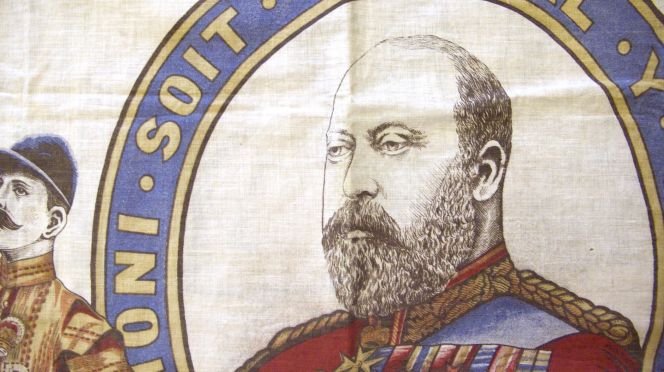 Close-up of the new King – Edward VII – 1901. This commemorative cotton cloth is measuring 79×90 cm. (Owner: Whitby Museum, SOH598). Photo: The IK Foundation, London.
Close-up of the new King – Edward VII – 1901. This commemorative cotton cloth is measuring 79×90 cm. (Owner: Whitby Museum, SOH598). Photo: The IK Foundation, London.Sources:
- Hansen, Viveka, The Textile History of Whitby 1700-1914, Whitby & London 2015, (research material, pre-publishing).
- Whitby Museum, Social History Collection (Commemorative textiles).
ESSAYS
The iTEXTILIS is a division of The IK Workshop Society - a global and unique forum for all those interested in Natural & Cultural History from a Textile Perspective.
Open Access essays - under a Creative Commons license and free for everyone to read - by Textile historian Viveka Hansen aiming to combine her current research and printed monographs with previous projects dating back to the late 1980s. Some essays also include unique archive material originally published in other languages, made available for the first time in English, opening up historical studies previously little known outside the north European countries. Together with other branches of her work; considering textile trade, material culture, cloth manufacturing, fashion, natural dyeing and the fascinating world of early travelling naturalists – like the "Linnaean network" – from a Global history perspective.
For regular updates, and to make full use of iTEXTILIS' possibilities, we recommend fellowship by subscribing to our monthly newsletter iMESSENGER.
been copied to your clipboard




– a truly European organisation since 1988
Legal issues | Forget me | and much more...
It is free to use the information/knowledge in The IK Workshop Society so long as you follow a few rules.
 LEARN MORE
LEARN MORE








